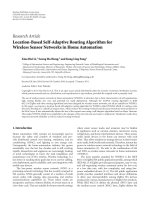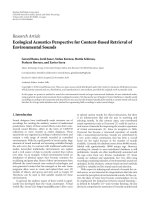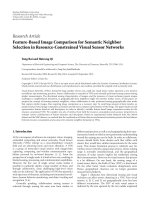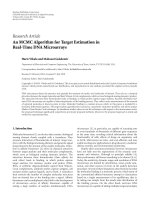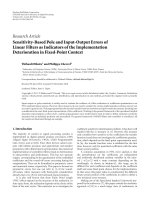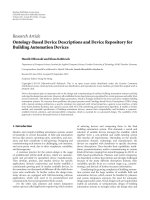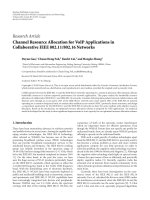Báo cáo hóa học: " Research Article Tree Based Protocol for Key Management in Wireless Sensor Networks" pptx
Bạn đang xem bản rút gọn của tài liệu. Xem và tải ngay bản đầy đủ của tài liệu tại đây (730.21 KB, 10 trang )
Hindawi Publishing Corporation
EURASIP Journal on Wireless Communications and Networking
Volume 2010, Article ID 910695, 10 pages
doi:10.1155/2010/910695
Research Article
TreeBasedProtocolforKeyManagementin
Wireless Sensor Networks
M L. Messai,
1
M. Aliouat,
2
and H. Seba
3
1
Ecole Doctorale ReSyD, Universit
´
e Abderrahmane Mira, Bejaia 06000, Algeria
2
D
´
epartement Informatique, facult
´
e des sciences, Universit
´
eFerhatAbb
`
es, S
´
etif 19000, Algeria
3
Laboratoire LIESP, Universit
´
e Claude Bernard Lyon1, IUT LYON1, 71, rue Peter Fink, 01000 Bourg-en-Bresse, France
Correspondence should be addressed to H. Seba,
Received 6 April 2010; Accepted 26 August 2010
Academic Editor: Zhiqiang Liu
Copyright © 2010 M L. Messai et al. This is an open access article distributed under the Creative Commons Attribution License,
which permits unrestricted use, distribution, and reproduction in any medium, provided the original work is properly cited.
Securing a wireless communication has generally a vital importance, particularly when this communication is in a hostile
environment like in wireless sensor networks (WSNs). The problem is how to create cryptographic keys between sensor nodes
to ensure secure communications. Limited resources of sensor nodes make a public key cryptosystem such as RSA not feasible. So,
most solutions rely on a symmetric cryptosystem. In this paper, we propose a new key management scheme based on symmetric
cryptography which is well adapted to the specific properties of WSNs. The evaluation of our solution shows that it minimizes
memory occupation, ensures scalability, and resists against the hardest attack: compromised nodes.
1. Introduction
The convergence of technological advances in microelectron-
ics and wireless communications has enabled the emergence
of a promising area: Wireless Sensors Networks (WSNs).
WSNs come from the combination of embedded systems
and distributed systems. WSNs have opened the way for a
multitude of research areas and the huge interest generated
by researchers activities calls for broad fields of applications
in the near future.
Sensors appear as miniaturized systems, equipped with
a processing unit and storage of data, a unit of wireless
transmission and a battery. Organized as a network, the
sensors (or nodes) of a WSN, despite resource constraints
in computing capacity, storage, and energy, have to play an
essential role in quasi all domains of human environment.
They are primarily dedicated to collect data from physical
phenomena such as monitoring global warming and send
them to a base station (also called the sink) [1]. Figure 1
shows an example of a WSN composed of ten sensor nodes
deployed randomly around a base station. Depending on
the size of the deployment area, the transmission range of
the sensor nodes, and the base station, sensor nodes can
communicate with the base station directly or indirectly
by computing a hop-by-hop route to it. Many barriers to
the common deployment of WSNs have to be overcome
before they can reach their full maturity. Among these
obstacles, the security problem is acute and must be
addressed adequately and in accordance with the binding
characteristics of WSNs. Because of their constraints and
their deployment in unattended and hostile environments,
the different nodes of a WSN are vulnerable to node
compromising and also to physical damage [2]. In addition,
the use of wireless transmission makes WSNs permeable to
all sorts of malicious attacks. Consequently, security is a real
challenge to rise.
Several key management protocols for WSNs were
proposed to respond to the security requirements of these
environments. Unfortunately, node compromising is rarely
or not enough investigated and most of these protocols have
a weak resilience to this attack. In this paper, we present a
symmetric-based key management solution for WSNs called
STKM (Spanning Tree Key Management for WSN). STKM
is a simple and robust solution to secure node-to-node
and node-to-base station communications. STKM assumes
a random deployment of nodes. It builds a tree that spans
all the sensor nodes. This tree allows key refresh with small
costs. Simulation results show that STKM is very resilient to
2 EURASIP Journal on Wireless Communications and Networking
BS
S
1
S
4
S
8
S
10
S
2
S
5
S
6
S
7
S
3
S
9
Figure 1: Example of WSN.
node compromise while preserving energy consumption at
the level of sensor nodes.
The rest of the paper is organized as follows. First, we
discuss related work in Section 2.InSection 3, we present our
solution and give its detailed algorithms. Section 4 is devoted
to an analysis and a simulation of the proposed solution.
Section 5 concludes our work.
2. Background and Motivation
Key management is the process by which cryptographic keys
are generated, stored, protected, transferred, loaded, used,
and destroyed [3]. Figure 2 lists a selection of existing key
management solutions proposed for WSNs in the literature,
for a detailed state of the art see [3]. Most existing key
management solutions are based on symmetric cryptography
mainly because of its reasonable energy consumption. Asym-
metric cryptography involves the use of a pair of keys (public
key and private key) to encrypt and decrypt messages. Each
node in the network has a public and a private key, the
first is known throughout the network, the second is secret,
that is, known only by the node. The source node encrypts
messages using the public key of the destination node, and
this latter uses its private key to decrypt received messages.
In symmetric cryptography, the source and the destination
use the same key to encrypt and decrypt messages. Asym-
metric cryptography offers better resistance against node
compromise attack and allows scalability but requires an
additional part on software and hardware of the nodes. Some
researchers investigated asymmetric cryptographic tools and
propose adapted solutions. Examples of such solutions are
Tiny Public Key (TinyPK)[4] and Tiny Elliptic Curve
Cryptosystem (TinyECC)[5].
With symmetric cryptography, the simplest idea is to
load a secret information in the sensor nodes before
their deployment in the network. This secret information
deployed in the network may be the secret key itself or an
auxiliary information that helps nodes to derive the real
secret key shared by the nodes. With this secret key, nodes
can securely exchange messages [3]. The main disadvantage
of this solution is that compromising one node (access to
the preloaded key) might lead to compromise the entire
network. To overcome this limitation, several researchers
propose schemes that establish pairwise keys rather than a
unique global key. For example in [6], the authors focus
on developing cost-saving mechanisms while weakening the
threat model. They propose Key Infection, a lightweight
security protocol suitable for use in noncritical commodity
sensor networks where an attacker can monitor only a fixed
percentage α of communication channels. With Key Infection,
a node wishing to communicate securely with other nodes
simply generates a symmetric key and sends it in the clear to
its neighbors.
In [7], Blon describes a Key-matrix-based dynamic key
generation solution. In this solution, some of the possible
link keys in a network of size N are represented as a (λ+1)
×N
key matrix. The scheme stores small amount of information
in each sensor node, so that some pair of nodes can calculate
corresponding field of the matrix, and uses it as the link key.
This solution is λ-secure, meaning that keys are secure if no
more than λ nodes are compromised.
Another λ-secure solution is presented in [8]andcalled
Polynomial-based key predistribution scheme. This scheme
distributes a polynomial share (a partially evaluated polyno-
mial of degree λ) to each sensor. So, each sensor node stores
a polynomial with λ +1coefficients and every pair of sensor
nodes can establish a key using the property of symmetry of
polynomials. The solution is λ-secure, meaning that coalition
of less than λ + 1 sensor nodes knows nothing about pairwise
keys of others.
In [9], the authors propose BROSK (BROadcast Session
Key negotiation protocol). With BROSK every node broad-
casts a message containing its nonce. So, every two neighbor-
ing nodes that hear each other can compute a common key
which is function of their two nonces. Neighboring nodes
authenticate themselves with a predeployed key which is
supposed to be unreachable in the case the node is captured.
In [10], the authors propose a variation of this protocol
where the predeployed key is used only for a restricted period
of time during which nodes establish pairwise keys. Then, the
predeployed key is erased. However, Hello messages used to
establish pairwise keys are sent in the clear. So, an attacker
that captures a node and also eavesdrops hello messages can
use the IDs and nonces contained in these messages to derive
established keys.
Perrig et al. propose in [11] SPINS, a key management
protocol that relies on a trusted base station to distribute
keys. SPINS contains two parts: SNEP (Secure Network
Encryption Protocol) that protects communications between
a node and the base station or between two nodes, and
μTESLA (microtime efficient streaming loss-tolerant authen-
tication) that serves to authenticate packets coming from the
base station. The first part is unsuitable to energy constraint
of nodes because any communication between two nodes
must pass through the base station. The second part needs
EURASIP Journal on Wireless Communications and Networking 3
Key management
in WSNs
Using asymmetric
cryptography
[4, 5]
Using symmetric
cryptography
No key pre-
distribution [6]
Master key based
pre-distribution [9, 10]
Paire-wise key
pre-distribution [7, 8]
Base station
participation [11]
Probabilistic key pre-
distribution [14, 15, 16]
Dynamic key
management [17]
Hierarchical key
management [12]
Location based
keys [13]
Figure 2: Existing key management solutions for WSNs.
additional memory space to store authentication keys. In
[12], the authors propose LEAP (Localized Encryption
and Authentication Protocol); a key management protocol
intended to support several communication patterns. In this
protocol, each node stores four types of keys: individual,
pairwise, cluster, and group. An individual key is a key shared
between a node and the base station. A pairwise key is shared
between a node and each of its neighbors. A cluster key is
a key shared between a node and all neighboring nodes.
A group key is a key common to the entire network. The
individual key is preloaded. After deployment, neighboring
nodes establish pairwise keys. They authenticate themselves
using a predeployed key which is erased as soon as pairwise
keys are established. To establish cluster keys and the group
key, nodes use broadcasts and message relaying. The protocol
uses μTesla [11] to authenticate broadcasts.
Liu et al. propose in [13] LBKs (location-based keys) that
relies on location information to achieve key management.
The keys are established according to the geographical
location of sensor nodes. However, knowing the geographical
location of nodes is not guaranteed with random deploy-
ment. Eschenauer and Gligor [14]proposeaschemebased
on a random key predistribution. In this scheme, each sensor
randomly picks a set of keys and their identifiers from a key
pool before deployment. Then, a shared-key discovery phase
is launched where two neighbors exchange and compare list
of identities of keys in their key chains. Basically, each sensor
node broadcasts one message and receives one message from
each node within its radio range where messages carry key
ID lists. So, any pair of nodes has a certain probability
to share at least one common key. The challenge of this
scheme is to find a good tradeoff between the size of the
key pool and the number of keys stored by nodes to achieve
the best probability. The main drawback of this approach
is that if the number of compromised nodes increases, the
fraction of affected links also increases. Other solutions use
the principle of probabilistic key predistribution [15, 16]
introduced in [14]. For example, the authors of [16]suppose
that the deployment area is a grid-based structure of t
∗
n cells
called groups. Groups contain the same number of sensor
nodes. The protocol uses t
∗
n key pools such that neighboring
key pools have more keys in common. Sensor nodes are
deployed with the key pool that corresponds to their group
in the deployment area. After deployment, nodes sharing
keys can communicate directly. Nodes that do not share keys
must establish a path key using their neighbors. In [15],
the authors propose to increase the amount of key overlap
required in the shared-key discovery phase. Their scheme
called Q-composite requires q common keys to establish a link
key. Link between a pair of sensor nodes is set as a hash of
all common keys. The scheme improves resilience because
the probability that a link is compromised, when a sensor
node is captured, decreases, but probability of key sharing
also decreases because a pair of nodes has to share q keys
instead of one.
Eltoweissy et al. [17]proposeEBS (Exclusion-based
System), a key scheme that assigns each node k keys from
akeypoolofsizek + m. If node capture is detected, rekeying
occurs throughout the network. However, the authors [17]
did not indicate a method for detecting a compromised node.
Moreover, even if a small number of nodes in the network
are compromised, information in the entire network could
be discovered.
Section 4 summarizes the properties of these different
solutions together with the proposed one within a table.
In general, existing symmetric key management solu-
tions for WSNs focus particularly on the efficiency of
key establishment after the deployment of the network.
4 EURASIP Journal on Wireless Communications and Networking
However, they do not deal with key refresh which makes key
management dynamic and adds a further difficulty to the
task of attackers. Furthermore, existing solutions neglect the
effect of captured node attacks.
We develop in this paper a key management framework
well adapted to WSNs challenges especially scalability. We
focus on establishing a key refresh scheme with minimum
costs that allows to deal with the resistance against the
hardest attack: node compromising.
3. STKM: A Spanning Tree-Based Key
Management Solution for WSNs
In this section, we describe a new key management protocol
forWSNs.Ourmainobjectiveistooffer a robust and simple
security framework that meets the resource constraints of
sensor nodes. The main idea of STKM is to build a tree
in a secure manner and while conserving energy after a
random deployment of nodes. Thereafter, this tree is used
for rekeying to save communications. In fact, with a tree only
log
2
(n) messages are necessary to rekey a network of n nodes.
We begin by presenting the assumptions and notations used
in the design of the solution, and then we give the detailed
algorithms.
3.1. Assumptions and Notation. Our solution relies on the
following assumptions.
(i) The sensor network is static (nodes are not mobile).
(ii) The sensor nodes are homogeneous: the sensor nodes
are similar in their processing capacity, communica-
tion, energy, and storage.
(iii) The deployment is random: the neighbors of any
node are not known prior to deployment.
(iv) An attacker can listen to all traffic, reflect old
messages, or inject its own messages.
(v) The compromise of a node implies that all informa-
tion stored in its memory is known by the attacker.
(vi) The base station has no constraints on the capabilities
of computing, storage and cannot be compromised.
(vii) The communication channels are bidirectional; if a
node u can receive a message from node v, then u can
send a message to v.
(viii) A base station which is generally the sink is responsi-
ble for initiating the key management process.
(ix) Each sensor node has a unique identifier.
Ta bl e 1 shows the notations that are used to write algorithms
in the remaining of the paper. Each sensor node i, including
the base station, maintains the following variables.
(i) Father
i
: the father of the sensor in the final spanning
tree. The base station is the root of the tree, so
Father
BS
is set to null.
(ii) Level
i
: the level of the sensor in the tree. The level of
the root is zero, that is, Level
BS
= 0.
(iii) Sons
i
: a list containing the identifiers of the sons of
node i within the tree.
(iv) Neighbors
i
: a list containing the identifiers of the
neighbors of node i. This list is maintained to cope
with node failure and node capture as described
further in this section.
The protocol uses the following types of messages.
(1) Hello, Sender ID, Sender Level, MAC
Kr
(Sender ID,
Sender Level, Sender Father)
Kr
: this message is used
to construct the spanning tree. It is encrypted with
the predeployed key K
r
. Sender ID is the identifier of
the sensor node that sends the message. The Sender
level is the position of the node in the tree. So, the
base station which is the root of the tree is at position
0.
(2)
{REFRESH, BS, New Kr, Mal List, MAC
KBS, Si
(BS ,
new
Kr)}
KBS, Si
: this message initiated by the base
station is used to update key Kr which is shared by
all the sensor nodes. Mal
List is a list of nodes that
are suspected to be malicious (captured nodes).
(3)
{REFRESH-REQ, S
i
, Mal
ID
Ki-BS
}: this message is
sent by a sensor node to the base station to request a
key refresh. A node S
i
requests a key refresh when it
suspects a neighbor Mal
ID to be captured.
(4)
{JOIN, S
n
, N
n
, MAC
Kr
(S
n
, N
n
)}
Kr
: this message is
used by a new node to join the network. S
n
is
the identifier of the new node and N
n
is a nonce
generated by him.
(5)
{Join-Ack, S
i
, Level
i
, N
n
, N
i
, MAC
Kr
(S
i
, Level
i
,
N
i
)}
Kr
: this message is used by neighboring nodes to
acknowledge the receipt of a Join request.
(6)
{Father, S
n
, S
i
, N
i
}
Kr
: this message is used by a new
node S
n
to inform surrounding nodes that its father
in the spanning tree is node S
i
.
3.2. Algorithm. Each sensor node S
i
is launched with three
keys: K
i,BS
, K
BS,i
and K
r
. K
i,BS
and K
BS,i
are shared with
the base station. They both serve to secure communications
between the sensor node S
i
and the base station. K
i,BS
serves
to encrypt/decrypt messages sent by S
i
to the base station
while K
BS,i
serves to encrypt/decrypt messages sent by the
base station to S
i
. The aim of using two keys is to make
more difficult the task of a cryptanalysis attacker. Key K
r
is
shared by all nodes of the network; this key is used to encrypt
(decrypt) messages immediately after deployment.
After deployment, each node copies its key K
r
in its
RAM (volatile memory) and removes it from its nonvolatile
memory (EROM). If an attacker captures (physical access)
a node after deployment, he will not have access to the key
K
r
rapidly. The base station initiates the construction of the
spanning tree by broadcasting a Hello message as follows:
BS
−→
∗
: {HELLO,BS,0,null, MAC
Kr
(
BS, 0,null
)
}
Kr
.
(1)
EURASIP Journal on Wireless Communications and Networking 5
Table 1: Notation.
Notation Description
S
i
ith sensor node in the network, S
i
denotes the (unique) identifier of the sensor node.
{M}
k
The encryption of message M with key k.
S
→
∗
: M AnodeS broadcasts the message M, any node in the radius of perception of the BS receives the message M.
MAC
k
(M) The Message Authentication Code of the message M with the symmetric key k.
A
|| B The concatenation of the information A with information B.
N
i
A nonce generated by node S
i
.
BS
s
1
s
4
s
8
s
10
s
2
s
5
s
6
s
7
s
3
s
9
(a)
BS
s
1
s
4
s
8
s
10
s
2
s
5
s
6
s
7
s
3
s
9
(b)
BS
s
1
s
4
s
8
s
10
s
2
s
5
s
6
s
7
s
3
s
9
(c)
Figure 3: Tree construction.
The purpose of this message is to discover neighboring nodes
of the base station. Upon receiving the message for the first
times each node S
i
set, its father to BS and sets its level in the
tree to 1. Then, S
i
broadcasts a similar message that is, S
i
→
∗
:{HELLO, S
i
,1,BS,MAC
Kr
(S
i
,1,BS)}
Kr
, in its neighboring
hood to allow other nodes to join the tree and so on until all
the nodes join the tree.
When receiving other Hello messages, each node uses
them to set its list of sons in the tree and computes common
keys with them or simply constructs its list of neighbors.
Algorithm 1 describes the detailed actions achieved by a
sensor node when receiving a Hello message.
Figure 3 shows some steps of the construction of the
spanning tree of the WSN depicted on Figure 1. Figure 3(a)
shows the first step where the neighbors of the base station
join the tree. In Figure 3(b), we only show the step during
which neighbors of nodes S5 join the tree. Finally, the
complete tree is depicted in Figure 3(c).
3.3. Tree Maintenance and Rekeying. Once the tree is con-
structed, each node shares a symmetric key with the base
station, a symmetric key with its father in the tree, and
the key K
r
with the whole network. A rekeying process is
launched by the base station periodically to refresh Kr as
follows.
(1) The BS sends to each son S
i
a Refresh message
encrypted with their common key K
BS,Si
{REFRESH,
BS,New
Kr, null, MAC
KBS,Si
(BS,new Kr)}
KBS, Si
.
Note that in a periodic refresh mal
ID is set to null.
However, if the base station issues the REFRESH
because of a captured node attack, it includes the ID
of this node in the message.
(2) When a son node of the base station receives the
Refresh message, it updates key K
r
by new Kr, then
it forwards the Refresh message of the base station
to its own sons. The message is encrypted with the
6 EURASIP Journal on Wireless Communications and Networking
Recieve {Hello, Sender ID, Sender Level, MAC
Kr
(, Sender ID, Sender Level, Sender Father)}
Kr
If the message is received for the first time Then
Father
i
:= Sender ID;/
∗
Father receives the identifier of the sender.
∗
/
Level
i
:= Sender Level +1;
If (Fatheri
/
= BS) Then
/
∗
Compute a common key with the father
∗
/
K
Si, Sender node
:= H
Kr
( S
i
Sender node Level
i
);
/
∗
if the father is the BS a shared key already exists.
S
i
→
∗
: {HELLO, S
i
, Level
i
, Father
i
, MAC
Kr
(S
i
, Level
i
, Father
i
)}
Kr
;
Else
If (Level
i
= Sender Level – 1) AND (Sender Father == S
i
) Then
Add the node Sender
ID tothelistofsons;
If S
i
<>BS then
Compute a shared key with the son Sender
ID:
K
Si, Sender ID
:= H
Kr
(S
i
Sender ID Level
i
+1);
EndIF
Else
Add the node S
i
tothelistofneighbors;
End IF
Algorithm 1:
symmetric key shared between father and son. So, the
Refresh message goes downward within the tree till
reaching all the sensor nodes. Thus, all sensor nodes
get the new global key.
A rekeying process may also be trigged if malicious/captured
nodes are detected in the network. Because they are resource
constrained, sensor nodes cannot implement mechanisms
for detecting malicious nodes. For example, putting a
sensor node in promiscuous mode is not feasible. Detecting
captured nodes is conceivable only if the captured node
issues attacks such as sending unnecessary messages to its
neighbors to cause energy depletion. When a node S
i
suspects
one of its neighbors, say S
m
, to be captured, two situations are
possible.
(i) If the suspected node S
m
is the son of S
i
,nodeS
i
ignores the messages of S
m
and removes it from the
list of sons. Then it generates a nonce N
i
and sends
{REFRESH-REQ, S
i
, S
m
Ki-BS
} to its father on the
tree. This message goes upward until it reaches the
BS. This last broadcasts a refresh message
{REFRESH,
BS,New
Kr, S
m
, MAC
KBS, Si
(BS,new Kr)}
KBS, Si
in
the tree. With this message, K
r
is updated and all
sensor nodes are aware that S
m
is malicious.
(ii) If the suspected node S
m
is the father of S
i
,node
S
i
must first contact one of its neighbors in the list
neighbors
i
to find another father and by the way
another path to reach the base station. If it succeeds in
this task, it issue a REFRESH-REQ as in the precedent
case.
In both cases, it is the base station that decides if it issues a
key refresh or not. We suppose that the base station has more
means and resources to detect malicious/captured nodes.
Captured nodes may also send REFRESH-REQ messages
only to consume energy and to evict honest nodes from
the network. If the base station detects this behavior, it may
issue a REFRESH message that evicts the node that sends the
REFRESH-REQ from the network.
Adding a new node S
n
is achieved as follows.
(1) S
n
generates a nonce N
n
and broadcasts a join
message as follows: S
n
→
∗
: {JOIN, S
n
, N
n
, MAC
Kr
(S
n
, N
n
)}
Kr
,TheJOIN message is encrypted with the
current value of K
r
, the key shared by all the sensor
nodes. So, the new sensor node must be launched
with this key at deployment. Note here that deploying
a new sensor must be synchronized with the periodic
rekeying process to avoid deploying a new node with
an obsolete key.
(2) When receiving the Join message, every node S
i
in the
transmission range of the new node generates a nonce
N
i
and responds with the following message:
{Join-Ack, S
i
, Level
i
, N
n
, N
i
, MAC
Kr
(
S
i
, Level
i
, N
i
)
}
Kr
.
(2)
(3) The new node declares the source of the first
received message as a father and diffuses the following
message:
{Father,S
n
, S
i
, N
i
}
Kr
.
(4) The father node adds the new son node in its sons list.
The surrounding nodes that heard the Father message
add the new node to their list of neighbors.
(5) The father and the son compute their shared keys.
A sensor node may fail or consume totally its energy. In this
case, nodes that are attached to him, especially its sons, must
search for another path to the base station. So, they ask the
nodes in their list of neighbors to take the place of the failed
father.
EURASIP Journal on Wireless Communications and Networking 7
4. Evaluation
4.1. Comparison with Exiting Solutions. In this section, we
evaluate the performance of our solution and compare it
with existing ones. We use the following metrics to achieve
this evaluation.
(i) Memory complexity: memory needed to store keys.
(ii) Communication Complexity: number of messages
exchanged for key management.
(iii) Key connectivity: the probability that two nodes (or
more) share a key.
(iv) Resilience against node capture: this metric measures
the impact of a node compromise on the security of
the rest of the network. We quantify this metric with
the three following values:
(a) good resilience: the compromised node affects
only its neighbors (local influence),
(b) weak resilience: the compromised node affects
its neighbors and also some nonneighboring
nodes,
(c) very weak resilience: if the compromise of one
node leads to compromise the whole network.
(v) Scalability: this metric measures the flexibility of the
protocol with the size of the network. In other words,
the metric shows how the cost of the protocol, that
is memory and message overhead, varies when the
network becomes larger. Scalability is a very impor-
tant metric to consider when distributed algorithms
are proposed, especially for dense WSNs. To quantify
scalability, we use the following values:
(a) very good: the protocol does not induce further
costs when the number of nodes in the network
increases,
(b) good: the protocol induces reasonable costs
when the number of nodes increases,
(c) medium: the cost of the protocol depends on
the number of nodes.
Ta bl e 2 presents the results of comparing key management
protocols described in Section 2 with the proposed solution.
The different notations used in the table are described in
Section 2. In the proposed scheme, a node needs to store
initially three keys before deployment. After deployment,
each node computes a number of keys that is the function
of the number of its neighbors. If a node S
i
has d neighbors,
where d
are sons, the set of keys stored by the node S
i
is two
keys (with the base station) + one key (shared by the whole
network) + d
keys. The memory complexity of our solution
is acceptable for nowadays sensors.
The analysis of the communication complexity for the
construction of the tree is measured by the number of
messages received and issued by each node. Each node sends
a message and receives d messages from its neighbors, that
is, d + 1 messages by each node. Our solution has a low-
complexity communication over other proposed solutions
50
0
Number of message received by each node
2
4
6
8
10
12
100 150 200 250
Sensor of nodes
300 350 400 450 500
Figure 4: Average number of messages for each node in a network
of 500 sensor nodes.
010
0
Captured links (%)
0.1
0.2
0.3
0.4
0.5
0.6
0.7
0.8
0.9
1
20 30 40 50 60
Number of captured nodes
70 80 90 100 110 120
Figure 5: Percentage of corrupted links versus number of captured
nodes.
[6, 9–13], moreover, it is deterministic; key connectivity is
equal to one (no concept of probability).
Preserving energy in WSNs is very important and having
a low communication complexity means that the solution
minimizes energy.
4.2. Simulation Results. To validate the results presented by
table II, we also measured the performance of our protocol
by simulation. In this section, we provide an overview of our
simulation model and some of the results we obtained. We
implemented our scheme within the MATLAB framework
(MATLAB for MATrix LABoritory is a matrix-based system
for scientific and engineering calculation). We considered
WSNs with 500 sensor nodes deployed randomly in an area
of 250
∗ 250 meters square. Each sensor node has a signal
range of 15 meters.
We first focused on evaluating the average number
of messages received by a sensor node after a random
deployment. This number of messages is equal to the number
of neighbors of the sensor node as explained earlier. Multiple
runs were conducted. Each run corresponds to a particular
random deployment of the 500 identified sensor nodes.
During each run, we measured the number of neighbors
8 EURASIP Journal on Wireless Communications and Networking
Table 2: Comparison.
Schemes
Metrics
memory
Complexity
communication
Complexity
Key connectivity
Resilience
against node
capture
Scalability
Key Infection
[6]
Depends on the
number of one
hop neighbors
(d)
For each node: 2
∗ d
100% Weak Good
BROSK [9]1 2
∗ d 100% Very weak Very good
Lightweight Key
Management
System [10]
4+2 g, where g is
number of
group in
network
2
∗ d 100% Very weak Very good
Blom Scheme
[7]
2(λ +1) d + 1 100% λ- secure Medium
Polynomial
scheme [8]
λ +1 d + 1 100% λ- secure Very good
SPINS [11]
5 + the chain list
of keys used by
μTESLA
3
∗(n/2) 100% Weak Medium
Random key
predistribution
[14]
Key pool size
(m) + keys
identifier s
d +1
Probability that
two nodes share
akey,sayp
1
Depends on m
and p
1
Good
Q-composite
[15]
2
∗ md+1
Probability that
two nodes share
akey,say
p
2
<p
1
Depends on m
and p
2
Medium
Key
management
using
deployment
knowledge [16]
d
− 1 d +1
Probability that
two nodes share
akey,sayp
3
Depends on d
and p
3
Good
Dynamic key
management
[17]
k keys + keys’
identifiers
d +1
Probability that
two nodes share
akey,sayp
4
Depends on k
and p
4
Good
LEAP [12]
(3
∗ d)+2+
keys chain of
μTESLA
(2
∗ d) + 1 100% Very good Good
Location-based
keys [13]
2
∗ d+1 2 ∗ d
Probability that
two nodes share
akey,sayp
5
λ-secure Good
Our solution
3+numberof
sons
d+1 100% Good Good
n:numberofnodesinthenetwork.d: number of neighbors. P
i
is the probability that two nodes share a key in the corresponding protocol. m is the size of the
key pool.
of each sensor node. We took the average of the values
registered at the level of each sensor node. Figure 4 illustrates
the obtained results. It appears that our random deployments
generate an average number of neighbors at most equal to
12. If the value of energy consumed by each type of message
is known, we can compute the total energy consumed during
tree construction.
We then considered the resilience of our scheme to node
capture. We compute the resilience to node capture by the
fraction of total communication links that are compromised
by the capture of x nodes. We assume that sensor nodes
are randomly captured by an attacker. Figure 5 presents the
obtained results. It shows that for a network of 500 sensor
nodes, an attacker must capture at least 100 sensor nodes to
reach all communications in the network. This corresponds
to 20% of nodes in the network.
We also carried out multiple experiments on networks
of size ranging from 500 to 1000 nodes. In each experiment
we computed the maximum number of messages that can be
received by a node. We took the average number of this value
for each network size. Figure 6 summarizes these results. It
shows how the number of messages received by a sensor node
EURASIP Journal on Wireless Communications and Networking 9
500 550
12
Maximum number of messages
14
16
18
20
22
24
600 650 700 750
Network size
800 850 900 950 1000
Figure 6: Maximum number of messages received by a node versus
network size.
evolves when the size of the network becomes larger. The
curve is almost logarithmic which is very acceptable.
4.3. Security Analysis. In this section, we analyze the security
of our solution. As mentioned in the assumptions (cf.
Section 3.1), the base station will not be compromised. An
outsider attacker, who does not know the key Kr, cannot
discover the meaning of messages diffused by nodes after
deployment. Nevertheless, an attacker can compromise one
or more nodes, so he becomes an insider attacker. The keys
of the compromised node can be used for forging wrong
messages (reading message, for example,) and also consume
nodes’ energy by sending useless messages to his sons and
father. If the base station can detect an abnormal behavior
of a node, it can lunch a rekeying to refresh K
r
and revoke
this node. In the following, we analyze the behavior of our
solution for three types of attack.
(1) HELLO flood attack: in our proposal, nodes dis-
cover their neighbors by sending a HELLO message
encrypted with the key K
r
. An attacker without
knowing the key K
r
could not launch a HELLO Flood
attack.
(2) Sybil attack: in the algorithm, an MAC of the
node’s identifier, its level, and its father’s identifier is
calculated to authenticate the sender and the receiver.
Therefore, a node cannot play a role of other nodes.
(3) Node capture attack: when a node is captured, this
does not affect its neighbors. In fact, after a node is
captured, what can an attacker do? Since he has the
key shared with the base station, he may send wrong
information (lectures) to that base station. The latter
may have a mechanism to verify the behavior of
sender nodes. The attacker also has access to the keys
of the sons of the victim enabling it thereafter to
send unnecessary messages to these sons in order to
consume their energy and cause battery depletion.
Nodes that detect these useless messages can suspect
the captured node and inform the base station with a
REFRESH-REQ message.
5. Conclusion
Security is a necessity for most applications using WSNs,
especially if the sensor nodes are deployed in unsafe
areas, such as battlefields, strategic places (airports, critical
buildings ). These sensor nodes operating in difficult
access places, without protection and without possibility of
recharging their batteries, may be subject to disruptive and
malicious actions. Therefore, it is important to provide to
them an acceptable security level. The primary objective of
WSN nodes is to collect data and transmit them to a decision
center. So, this must be done in a trustworthy and safe way. In
this paper, we presented a key management solution to WSN
that deals with one of the hardest attack: node capture. The
main idea of the solution is to quickly and cheaply build a
spanning tree that serves to refresh the shared key with min-
imum costs. The solution is scalable and uses little memory.
As a perspective of our present work, we plan to use the
NS2 simulator to compare the performance of our solution
with other solutions from the literature. We also work on a
mobile version of our scheme.
References
[1] I. F. Akyildiz, W. Su, Y. Sankarasubramaniam, and E. Cayirci,
“A survey on sensor networks,” IEEE Communications Maga-
zine, vol. 40, no. 8, pp. 102–114, 2002.
[2] T. Kavitha and D. Sridharan, “Security vulnerabilities in
wireless sensor networks: a survey,” Journal of Information
Assurance and Security, vol. 5, pp. 31–44, 2010.
[3]Y.Xiao,V.K.Rayi,B.Sun,X.Du,F.Hu,andM.Galloway,
“A survey of key management schemes in wireless sensor
networks,” Computer Communications, vol. 30, no. 11-12, pp.
2314–2341, 2007.
[4] R. J. Watro, D. Kong, S F. Cuti, C. Gardiner, C. Lynn, and
P. Kruus, “TinyPK: securing sensor networks with public key
technology,” in Proceedings of the 2004 ACM Workshop on
Security of Ad Hoc and Sensor Networks (SASN ’04), pp. 59–
64, October 2004.
[5] P. Ning and A. Liu, “TinyECC: elliptic curve cryptog-
raphy for sensor networks,” />software/TinyECC/.
[6] R. Anderson, H. Chan, and A. Perrig, “Key infection: smart
trust for smart dust,” in Proceedings of the 12th IEEE Interna-
tional Conference on Network Protocols (ICNP ’04), pp. 206–
215, October 2004.
[7] R. Blom, “An optimal class of symmetric key generation
systems,” in Proceedings of the Eurocrypt 84 Workshop on
Advances in Cryptology: Theory and Application of Crypto-
graphic Techniques, pp. 335–338, Springer, 1985.
[8] C. Blundo, A. D. Santix, A. Herzberg, S. Kutten, U. Vaccaro,
and M. Yung, “Perfectly-secure key distribution for dynamic
conferences,” in Proceedings of the 12th Annual International
Cryptology Conference on Advances in Cryptology, pp. 471–486,
Spring, Berlin, Germany, 1992.
[9] B. Lai, S. Kim, and I. Verbauwhede, “Scalable session key
construction protocol for wireless sensor networks,” in Pro-
ceedings of the IEEE Workshop on Large Scale RealTime and
Embedded Systems (LARTES ’02), 2002.
[10] B. Dutertre, S. Cheung, and J. Levy, “Lightweight key manage-
ment in wireless sensor networks by leveraging initial trust,”
SDL Technical Report SRI-SDL-04-02, 2004.
10 EURASIP Journal on Wireless Communications and Networking
[11] A. Perrig, R. Szewczyk, V. Wen, D. Culler, and J. D. Tygar,
“SPINS: security protocols for sensor networks,” in Proceed-
ings of the 7th Annual International Conference on Mobile
Computing and Networking, pp. 189–199, ACM Press, July
2001.
[12] S. Zhu, S. Setia, and S. Jajodia, “LEAP: efficient security
mechanisms for large-scale distributed sensor networks,” in
Proceedings of the 10th ACM Conference on Computer and
Communications Security (CCS ’03), pp. 62–72, October 2003.
[13] D. Liu and P. Ning, “Location-based pairwise key establish-
ments for static sensor networks,” in Proceedings of the 1st
ACM Workshop on Security of Ad Hoc and Sensor Networks
(CCS ’03), pp. 72–82, October 2003.
[14] L. Eschenauer and V. D. Gligor, “A key-management scheme
for distributed sensor networks,” in Proceedings of the 9th ACM
Conference on Computer and Communications Security, pp. 41–
47, November 2002.
[15] D. Liu, P. Ning, and L. I. Rongfang, “Establishing pairwise
keys in distributed sensor networks,” ACMTransactionson
Information and System Security, vol. 8, no. 1, pp. 41–77, 2005.
[16] W. Du, J. Deng, Y. S. Han, S. Chen, and P. K. Varshney,
“A key management scheme for wireless sensor networks
using deployment knowledge,” in Proceedings of the IEEE
International Conference on Computer Communications (IEEE
INFOCOM ’11), pp. 586–597, March 2004.
[17] M. Eltoweissy, M. Moharrum, and R. Mukkamala, “Dynamic
key management in sensor networks,” IEEE Communications
Magazine, vol. 44, no. 4, pp. 122–130, 2006.


